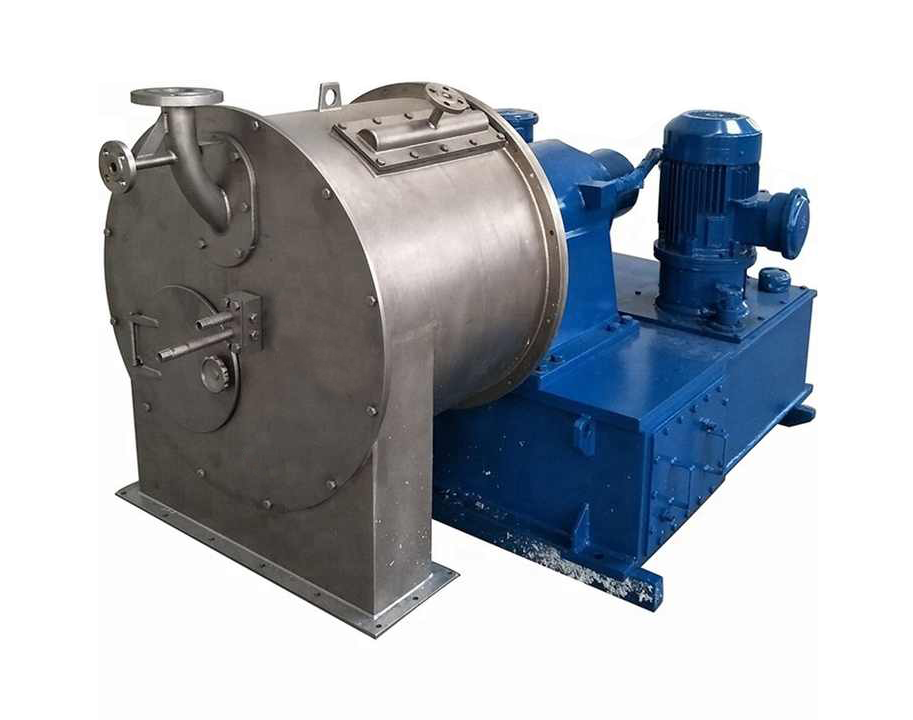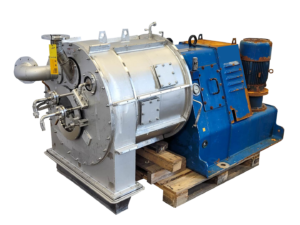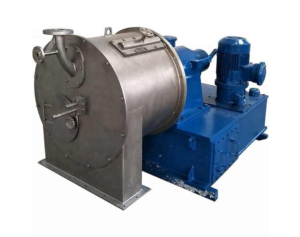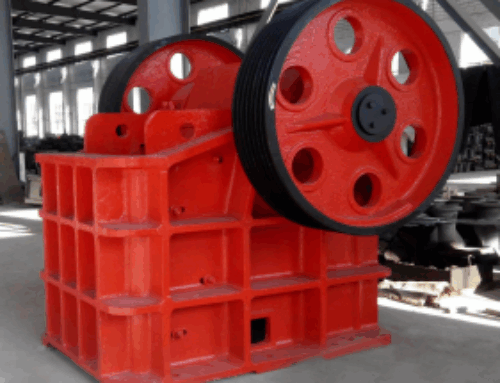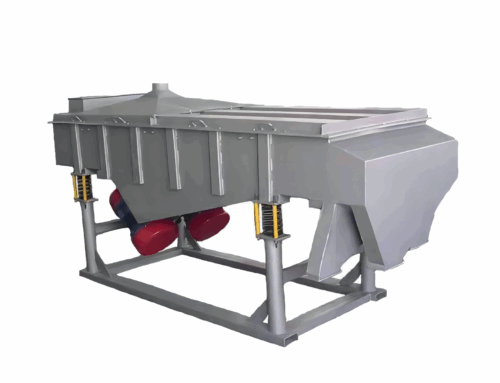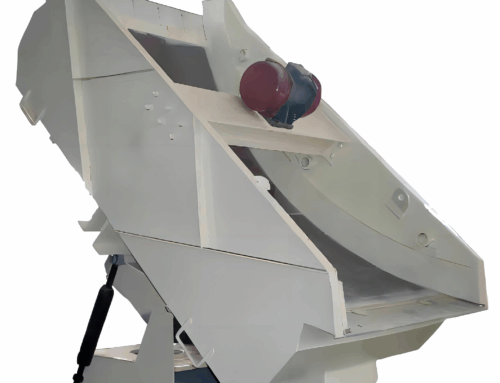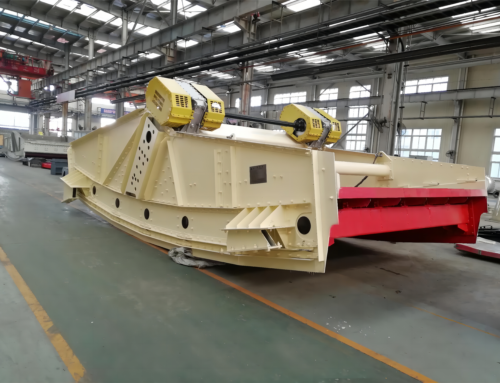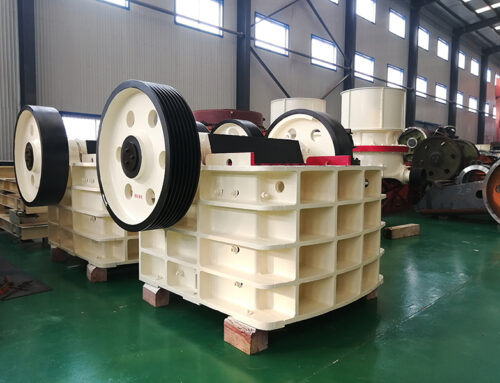Pusher centrifuges play an indispensable role at every key point in the grand map of the modern pharmaceutical industry. From the traditional chemical pharmaceutical raw material refining, to the biopharmaceutical cell debris and protein separation, and then to the pharmaceutical preparations of excipients and active ingredients accurate screening, the pusher centrifuge by virtue of its unique separation of skills, throughout the whole process of the birth of drugs. It rotates at high speed, with strong centrifugal force, the complex mixture of material disassembled into a pure single component, for the subsequent drug development and production of the smooth progress of the cornerstone, is the core of the pharmaceutical enterprises to achieve high efficiency, stability and high quality production.
一.The working principle of the pusher centrifuge
The working principle of pusher centrifuges in the pharmaceutical industry is mainly based on the synergistic operation of centrifugal force action and the pusher system, as described below:
When the drum of the pusher centrifuge rotates at high speed, a strong centrifugal force will be generated (different components in the material are subjected to different centrifugal forces due to the differences in density and particle size, etc.) Under the action of centrifugal force, solid particles of higher density will be thrown to the drum wall, forming a slag layer; while the liquid of lower density will flow out of the drum through the slag layer and the holes on the wall of the drum to realise solid-liquid separation. For example, in the production of antibiotic APIs, solid impurities such as mycelium in the fermentation broth can be separated from the liquid containing antibiotics in this way.
The material enters the drum of the centrifuge through the feed tube, and under the action of the feeding device, it is evenly distributed on the screen of the drum. For example, in some tablet production, the material to be separated is uniformly fed into the drum in preparation for subsequent separation.
Pusher centrifuges are equipped with a pusher, which is usually driven by a hydraulic system or a mechanical drive. As the drum rotates, the pusher reciprocates. When the pusher pushes forward, it pushes the layer of filter residue already formed on the drum wall forward for a certain distance, so that the filter residue moves gradually inside the drum towards the outlet.
Pusher reciprocating motion frequency and drum rotation speed to match, so that the material can continuously enter the drum, while the filter residue can also be continuously pushed out of the drum, the liquid is continuously outflow, to achieve continuous solid-liquid separation process. Take some pharmaceutical companies to produce powder raw materials for capsule filling as an example, the pusher centrifuge can continuously process a large amount of materials to ensure production efficiency.
The inner wall of the drum is usually lined with filtration media such as filter mesh, and its pore size is selected according to the material separation requirements. Filter media can prevent solid particles from passing through, so that the liquid passes through smoothly, but also to ensure a certain filtration speed and separation effect. In the production of vaccines and other biological products, the precise selection of filter media can effectively separate different components.
Through the control system, the rotating speed of the drum, the pushing frequency of the pusher, the feeding speed and other parameters can be precisely adjusted to meet the requirements of different pharmaceutical processes and material characteristics. For example, in the production of some temperature-sensitive drugs, the control system can adjust the parameters according to the material temperature and other factors in real time to ensure product quality.
二.Advantages of Pusher Centrifuges in the Pharmaceutical Market
1.Efficient separation
In the highly competitive pharmaceutical market, time is money. Compared to traditional separation methods such as gravity settling and filtration, there is a quantum leap in efficiency. Antibiotic production, for example, the traditional filtration process to deal with a batch of bacteria-containing fermentation broth may take several hours, during which is also prone to microbial growth, impurity re-dissolution and other issues affecting product quality. With the powerful centrifugal force generated by high-speed rotation, the pusher centrifuge can accurately separate the mycelium, medium residue and antibiotic active ingredients in the fermentation broth in just a few minutes, greatly shortening the production cycle. In the large-scale industrial production line, multiple pusher centrifuges work together and can handle several tonnes of materials per hour, allowing pharmaceutical companies to respond quickly to market demand, seize the first opportunity, and bring lucrative economic benefits to the enterprise.
2.Precise control
The quality of drugs is related to the life and health of patients, and the pusher centrifuge, with its precise control function, has become the ‘lynchpin’ of quality assurance. On the operation panel, the operator can finely adjust the key parameters such as rotational speed, pushing frequency and centrifugation time of the centrifuge according to different drugs and different process stages. For example, in the production of insulin, for the separation of insulin crystals and mother liquor, the slightest parameter deviation may lead to irregular crystal shape and reduced purity. Through precise setting of centrifuge parameters, the centrifuge separates the material with just the right centrifugal force to ensure that the insulin crystals are intact and pure, and the biological activity is not impaired, which is perfectly in line with the strict quality standards of pharmaceuticals. This precise control is carried out throughout the whole pharmaceutical process, from the initial processing of raw materials to the refining of finished products, to ensure the high quality of every bottle and every capsule of drugs.
3.Automated operation
The automatic operation feature of the pusher centrifuge brings the ‘gospel’ of manpower liberation for pharmaceutical enterprises. In the whole separation process, from the automatic feeding and continuous separation of materials to the automatic launching and unloading of the filter cake, all in one go, without the need for frequent human intervention. On the one hand, this greatly reduces the dependence of pharmaceutical enterprises on manpower, reduces manpower costs, and reduces the burden and increases the efficiency for the enterprise at a time when labour costs are rising; on the other hand, automated operation minimizes the risk of error and contamination caused by human factors. In the sterile drug production workshop, the fewer operators, the smaller the chance of microbial contamination, the pusher centrifuge strictly follow the preset procedures for stable operation, to ensure that the drugs in a high degree of cleanliness under the environment of efficient production, so that the production management of the pharmaceutical enterprises to save more heart, save energy.
4.Easy to clean
The pharmaceutical industry requires extremely high hygiene standards, and the pusher centrifuge, with its easy-to-clean structural design, has become a ‘good helper’ for hygiene maintenance. Its drum, screen, pusher parts, etc. are mostly made of stainless steel, with a smooth surface, not easy to adsorb materials, and corrosion-resistant, easy to clean and disinfect. At the same time, the internal structure of the centrifuge is compact, no complex dead ends and gaps, in the production batch switching or routine maintenance, cleaning personnel can easily use high-pressure water guns, special cleaning agents for internal all-round rinsing, wiping to ensure that there is no material residue, no microbial growth.
三.Selection and Maintenance Points
1.Selection Guide
For pharmaceutical companies, first of all, capacity planning is the core consideration. Large-scale production of APIs, such as vitamin C and other bulk APIs, the daily handling of materials up to tens of tonnes or even hundreds of tonnes, at this time you need to choose a large-sized, high-capacity pusher centrifuges; while small pharmaceutical companies research and development or the production of characteristics of small varieties of drugs, the material handling capacity is small, small, flexible centrifuges, accurate selection of pusher centrifuges can be avoided to avoid equipment idling and waste of resources.
Secondly, the material characteristics should not be ignored. If the material is highly corrosive, such as chemical synthetic drug intermediates containing acidic components, priority should be given to 316L, titanium and other corrosion-resistant materials such as the body of the centrifuge; for high-viscosity materials, such as polysaccharide solution in the biopharmaceuticals, need to choose to have a stronger push power to prevent the material from adhering to the model. At the same time, pharmaceutical companies must comply with regulatory requirements, pharmaceutical workshops need to comply with GMP standards, which requires centrifuges are designed to be easy to clean, disinfection, no hygiene dead ends, preferably equipped with in-place cleaning (CIP), in-place sterilisation (SIP) function, and non-toxic materials, non-reactive with the drug, a full range of protection of drug quality and production compliance.
2.Routine Maintenance
Cleaning work takes the brunt, after the end of each batch of production, you need to use a mild detergent or special cleaning solvents to wipe the drum, screen, pusher parts and other key parts in a timely manner, to remove residual material, to prevent drying of materials, corrosion of the equipment, and periodically also need to be cleaned in depth, such as the use of a high-pressure water gun to rinse the internal crevices, dead ends, to ensure that the equipment clean and sterile; lubrication link is critical, according to the equipment manual, the bearings, the piston, transmission parts, etc., regularly filled with appropriate amounts of high quality Lubrication is crucial, according to the equipment manual, regular bearings, pistons, transmission parts, etc. Add the right amount of high-quality lubricants, such as food-grade, pharmaceutical-grade lubricants, to ensure smooth operation, while paying attention to the state of the lubricant, if deterioration, contamination needs to be replaced in a timely manner to avoid increased wear and tear of parts.
If there is damage, clogging to the filtration efficiency decline, should be immediately shut down to replace; seal aging, deformation will lead to material leakage, contamination, need to be regularly inspected and updated as needed. In addition, real-time monitoring of equipment operating parameters is a ‘rainy day’ move, with the help of sensors continue to focus on speed, temperature, vibration amplitude, etc., once abnormal fluctuations are found, such as unstable speed, temperature soaring, immediately shut down to investigate the fault, to prevent small problems from evolving into big accidents, to ensure that the centrifuge is always in the best operating condition, for the production of pharmaceutical companies! Build a firm foundation for the production of pharmaceutical enterprises.

